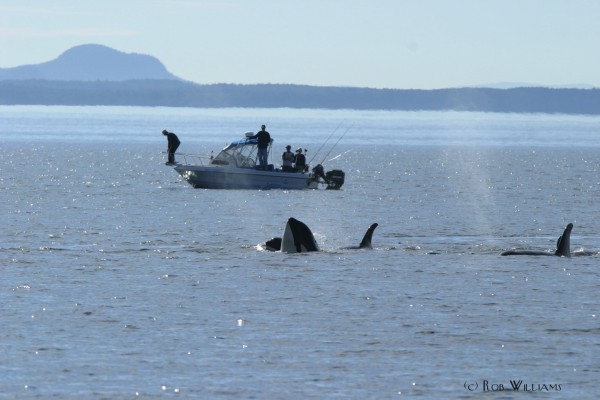
Our colleagues at Northwest Fisheries Science Center recently released an impressive summary of their work on critically endangered Southern Resident killer whales over the last 10 years. We applaud the quantity and quality of research on the population, and think more agencies should do this kind of outreach to summarize technical work on complicated subjects.
But we were struck by the reaction of our friend, colleague & frequent co-author, Dr David Bain. Dr Bain wrote this on his Facebook page, and has given us permission to reprint it here in its entirety. Please note that the headline is ours, not his. Dr Bain’s comments are reprinted below, in italics. What do you think?
“Science is about what we believe and how certain we are that it is true. In 2002, I was a co-organizer of the Orca Recovery Conference on what was known about Southern Resident Killer Whales and what could be done to recover them, the same ground covered by this new report (the conference report is still available on the Earth Island website, in case anyone is interested in what we thought in the “old days”). Very little has changed in what we believe, but today there is a lot more certainty that our beliefs are true.
As for genuine progress in understanding, there is a a little that is new. The satellite tracks indicate how far offshore SRKWs went on a couple of their trips to California. We know about PBDEs (flame retardants) in their blubber. We have enough data on age, sex, birth order, and reproductive history to extrapolate toxin burdens to individuals who have not actually been measured. We’ve added suppression of foraging behavior to the effects of vessel traffic.
But overall, they ate what we thought they ate, have the toxin levels we thought they had, and the effects of disturbance are about what we thought they were. So, there’s no surprise that we haven’t seen signs of recovery. The effort has been on double checking results of previously completed work with more sophisticated techniques and larger sample sizes, not implementing recovery actions.
Three SRKW specific recovery actions have been taken. One was designed to reduce but not eliminate the effects of disturbance. The other two are partial steps toward preparing for emergencies: oil spills and disease outbreaks. The first obviously has been too little, and the other two need to be completed before it is too late. E.g., the report notes that in 2002 we demonstrated that we knew how to reunite an isolated whale with its pod, but that knowledge was not applied to an isolated SRKW, and he died as a result.
The big steps still need to be taken. The removal of the Elwha dams is a start, and recolonization of the upper Elwha by chinook salmon may start to benefit SRKWs in about 15 years. If Washington State were to drop its appeal of the culvert replacement ruling and complete replacement by 2030 as ordered, SRKWs would see the benefits of that over the next 30 years. If the federal government would agree to start removing Snake River dams now instead of going back to the judge each year with a new set of reasons for putting it off, SRKWs might start seeing the benefit of that in 30 years, if they’re still around (the listing petition calculated that in the absence of action, SRKWs could become extinct as early as 2035, and Congress has set a pace to complete the research needed to finalize the recovery plan in the 2050’s). If we could get everyone who watches whales to spend equal time restoring salmon spawning habitat, along with the above government actions, we could make real progress on dealing with the prey availability problem (so whale watch operators, quit whining about unfairly being made the scapegoat and do what it takes for history to record you as the heroes who succeeded in starting recovery while governments fiddled).
The other big step is dealing with toxins. That means actually cleaning up superfund sites in SRKW habitat and adjacent coastal watersheds. That means convincing people to use their time instead of chemicals to remove weeds. It means paying attention to what our cars put onto streets and parking lots, and ultimately into stormwater and the food web (oil and other chemicals that leak, metals such as lead and copper that flake off). It means being more selective about the use of flame retardants (e.g., if your home has a good sprinkler system and no one smokes, you might be able to get by without them in a lot of products).
And last but not least, there is the matter of scrubbing carbon dioxide out of the ocean and atmosphere. Ocean acidification and climate change threaten to offset progress that could be made to improve prey availability. That’s going to require societal-scale change in transportation, energy, land use and restoration policies.
The report outlines research on killer whales NOAA hopes to accomplish over the next ten years. But, I have to wonder whether they plan to study the wrong species. To recover killer whales, don’t we really need to study human behavior, so we can discover how to get approval to actually implement the recovery actions we’ve been putting off the last ten years?”


Bandar Togel indonesia
Nice
Thanks for sharing the great advice, tips and what needs to be done (from Dr. Bain). Also, great spy-hopping photo! 😉
Pingback:#Saving Southern Resident #Orcas ~ Time for Act...